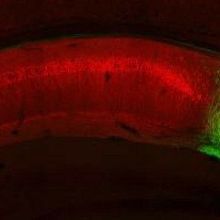fluorescent protein

Serendipity, Happenstance, and Luck: The Making of a Molecular Tool
Shelby Bradford, PhD | Dec 4, 2023 | 10+ min read
The common fluorescent marker GFP traveled a long road to take its popular place in molecular biology today.

Infographic: DNA Damage Viewed with Unprecedented Clarity
Amanda Heidt | Aug 15, 2022 | 2 min read
A new genetic sensor called PRISM makes use of a host cell’s DNA replication machinery to trigger fluorescence in neurons with damaged DNA.

DNA Damage Viewed with Unprecedented Clarity
Amanda Heidt | Aug 15, 2022 | 3 min read
A new tool called PRISM draws on virus-host interactions and a DNA repair pathway to help researchers visualize how cellular stress may contribute to neurodegenerative disease.

Certain Color Varieties of a Coral Are More Protected from Bleaching
Lisa Winter | Feb 25, 2021 | 2 min read
In yellow-green and purple versions of the reef-building Acropora tenuis, the genes that code for particular fluorescent and other colorful proteins become more active in the summer, protecting symbiotic algae from thermal stress and resisting bleaching.

Researchers Produce Alpaca Antibodies Using Yeast
Catherine Offord | Feb 13, 2018 | 2 min read
With multiple applications in biomedicine, the antibodies can now be made quickly, cheaply, and without the need for an alpaca or one of its relatives.

Image of the Day: Hippocampal Jalapeno
The Scientist | Aug 30, 2017 | 1 min read
To tease apart brain regions involved in forming versus remembering memories, scientists engineered mice whose brain cells could be manipulated and tagged.

Image of the Day: A Heart is Born
The Scientist | Aug 28, 2017 | 1 min read
To track distinct populations of developing cardiovascular cells, scientists used pulses of electricity to introduce fluorescently labeled DNA into chick embryos.

Notable Science Quotes
The Scientist | Oct 1, 2016 | 2 min read
Roger Tsien R.I.P., predatory publishing, and diversity in science

Nobel Laureate Roger Tsien Dies
Kerry Grens | Aug 31, 2016 | 2 min read
One of the pioneers in developing fluorescent proteins for biological studies was 64 years old.

Updated Tissue-Clearing Protocol Extends Time Frame for Imaging
Kerry Grens | Aug 23, 2016 | 1 min read
“Ultimate DISCO” uses a solvent that shrinks whole animals and preserves fluorescence for months.

Grab ’n’ Glow
Ruth Williams | Jan 1, 2015 | 2 min read
Engineered proteins can tether multiple fluorescent molecules to give a brighter signal—and that’s not all.

Predicting Worm Lifespan
Jef Akst | Feb 13, 2014 | 1 min read
Scientists engineer fluorescing nematodes to project the worms’ expected lifespans through flashes of light at just three days old.

Glowing Green Eel
Chris Palmer | Jun 17, 2013 | 2 min read
The Japanese freshwater eel is the first vertebrate found to produce a fluorescent protein, which may prove useful in the clinic.

What Ever Happened to Douglas Prasher?
Bob Grant | Feb 26, 2013 | 4 min read
The first researcher to clone the gene for green fluorescent protein, but who was passed over for the 2008 Nobel Prize in Chemistry, is back in academic science.
DayGlo Science
Laura Geggel | Jul 19, 2012 | 4 min read
Biologist David Gruber studies radiant creatures and their fluorescent proteins.
Live and In Color
Sarah Webb, Knowable Magazine | Apr 1, 2012 | 7 min read
How to track RNA in living cells
Encrypting E. coli
Kerry Grens | Sep 26, 2011 | 3 min read
Researchers design patterns of fluorescent protein expression to deliver secret messages.
